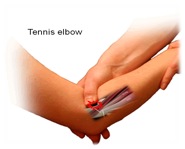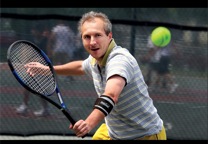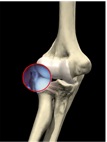Tennis elbow
 LATERAL EPICONDYLITIS (Tennis elbow)
LATERAL EPICONDYLITIS (Tennis elbow)
Tennis elbow is a problem with the tendons that attach to the lateral epicondyle, which is the bony bump on the outer side of the elbow. The muscles which attach here pull the wrist upwards and are called extensor muscles. These muscles join together to form a common extensor tendon, which attaches to the lateral epicondyle. This condition is caused by a constant pain in the common extensor tendon as it inserts into the bone of the lateral epicondyle.
Symptoms include tenderness and pain over the outer side of the elbow and specifically at the lateral epicondyle. This pain is made worse by bending the wrist upwards against resistance. It can also be aggravated by repetitive movements such as using a computer mouse.
Why have I got tennis elbow?
The cause is believed to be minor injury within the substance of the tendon; which then tries to heal. For reasons we do not understand this healing process gets switched off, leaving fibrous tissue behind instead of healthy tendon. The tendon tries to heal again and the repeated process leaves an increasing amount of painful abnormal tissue in the tendon. Once the abnormal tissue has formed, 'tennis elbow' is established.
What are the non operative treatment options?
Treatment includes rest, an arm brace or wrist splint, ice and anti-inflammatory medication. The mainstay of treatment is physiotherapy, specific exercises to stretch out the tendons and reduce the 'pull' at the tendon insertion into the bone of the lateral epicondyle. Counterforce bracing and ultra sound treatment has also had success.
 If simple measures do not work or the pain is disabling steroid injections are used. The steroid works as a strong local anti-inflammatory and relieves the symptoms effectively. Steroids should only be used if the pain has not settled within the first 3 months. It is important to have physiotherapy after the injection to stretch the tendons of the common extensor origin. Injections alone will not cure the tennis elbow and without physiotherapy the symptoms return. Repeat injection will settle the symptoms again, but repeated injections have diminished benefit and can cause thinning of the skin (lipodystrophy) and skin colour changes.
If simple measures do not work or the pain is disabling steroid injections are used. The steroid works as a strong local anti-inflammatory and relieves the symptoms effectively. Steroids should only be used if the pain has not settled within the first 3 months. It is important to have physiotherapy after the injection to stretch the tendons of the common extensor origin. Injections alone will not cure the tennis elbow and without physiotherapy the symptoms return. Repeat injection will settle the symptoms again, but repeated injections have diminished benefit and can cause thinning of the skin (lipodystrophy) and skin colour changes.
A new treatment called Platelet Rich Plasma (PRP) injections has recently been shown to be as effective as surgery. PRP has been used in clinical practice since the 1970s, but more recent studies and advances in technology have demonstrated benefits in its use in the treatment of tennis elbow. PRP is rich in growth factors which heal tendon and help the white cells carry away dead tissue. It is taken from your own blood after it has been spun down for 15 minutes in a centrifuge. The PRP is then injected into the tennis elbow tendon. Because the materials used in the treatment are extracted from the patients own blood, the chance of adverse drug reactions is eliminated, making the process completely safe. In addition, with the use of closed PRP systems, no other product or material is allowed to enter during the PRP production process. Although there is a large amount of basic science research on PRP, clinical studies are only now appearing in the literature. Therefore it is not widely used by all clinicians and it's exact benefits in the clinical setting are yet to be properly defined.
What should I expect after PRP injection?
After the injection you will have a sterile dressing which should stay on for 48 hours. Keep it clean and dry. Injections into soft tissues and joints can be very effective in giving pain relief when the tissues are inflamed. The injection that you have had includes the platelet rich plasma and a local anaesthetic, which numbs the area temporarily (2 -8 hours). It is normal to feel some increased discomfort in the area for 48 hours after the injection. Use ice and paracetamol for pain but it is essential that you do not use non steroidal anti-inflammatory drugs (such as neurofen, ibuprofen, volterol etc). However if you notice any of the following symptoms: swelling, redness or warmth around the injection site, or you feel generally unwell, please contact your GP or casualty and tell them about this injection. Unlike steroid injections, to gain the most benefit from PRP injection it is important that you rest the joint from any strenuous activity for four weeks. Do not lift anything more than 2 Kg (2 bags of sugar) or carry out any repetitive movement which previously aggravated the elbow symptoms. You will be able to carry out other light activities of daily living as normal.
It is important that you attend your review appointment in 2-3 weeks so that we can assess the effects of the injection and provide you with additional advice as appropriate. At this stage you will be referred for physiotherapy to start rehabilitation exercises.
What are the operative treatments?
In a few cases the symptoms do not settle with these non operative measures and if the pain is disabling may require surgery. It is important that your  surgeon has excluded other causes of pain around the outside of the elbow such as; radiocapitellar synovitis, arthritis, a plica or radial tunnel syndrome.
surgeon has excluded other causes of pain around the outside of the elbow such as; radiocapitellar synovitis, arthritis, a plica or radial tunnel syndrome.
If the pain is coming from tennis elbow alone- a small release of the tendon through an 8mm incision will relieve the symptoms in the majority of cases. After the operation the elbow will be painful and regular pain killers should be taken such as ibuprofen (unless contraindicated) and paracetemol. The incision is usually closed with absorbable sutures which do not need to be removed.
If there is a suggestion that there may be other problems inside the joint then an elbow arthroscopy can help to diagnose and treat these conditions prior to the tennis elbow release.
What should I expect after the operation?
The big bandage should be removed at 5 days. The sticky dressing underneath should be kept clean, dry and removed after 2 weeks. The elbow can be used as able and full range of motion must be achieved by the end of 2 weeks. No harm will occur even though it may be painful to move. Physiotherapy may be necessary.
Driving and return to work.
Driving can be resumed as soon as it is comfortable which is sometimes just a few days. Office works as soon as you feel able. Manual workers will typically need 6 weeks off work, or return to light duties only. It takes a long time to fully recover from this surgery and the elbow can have niggling pain for 3 months.



